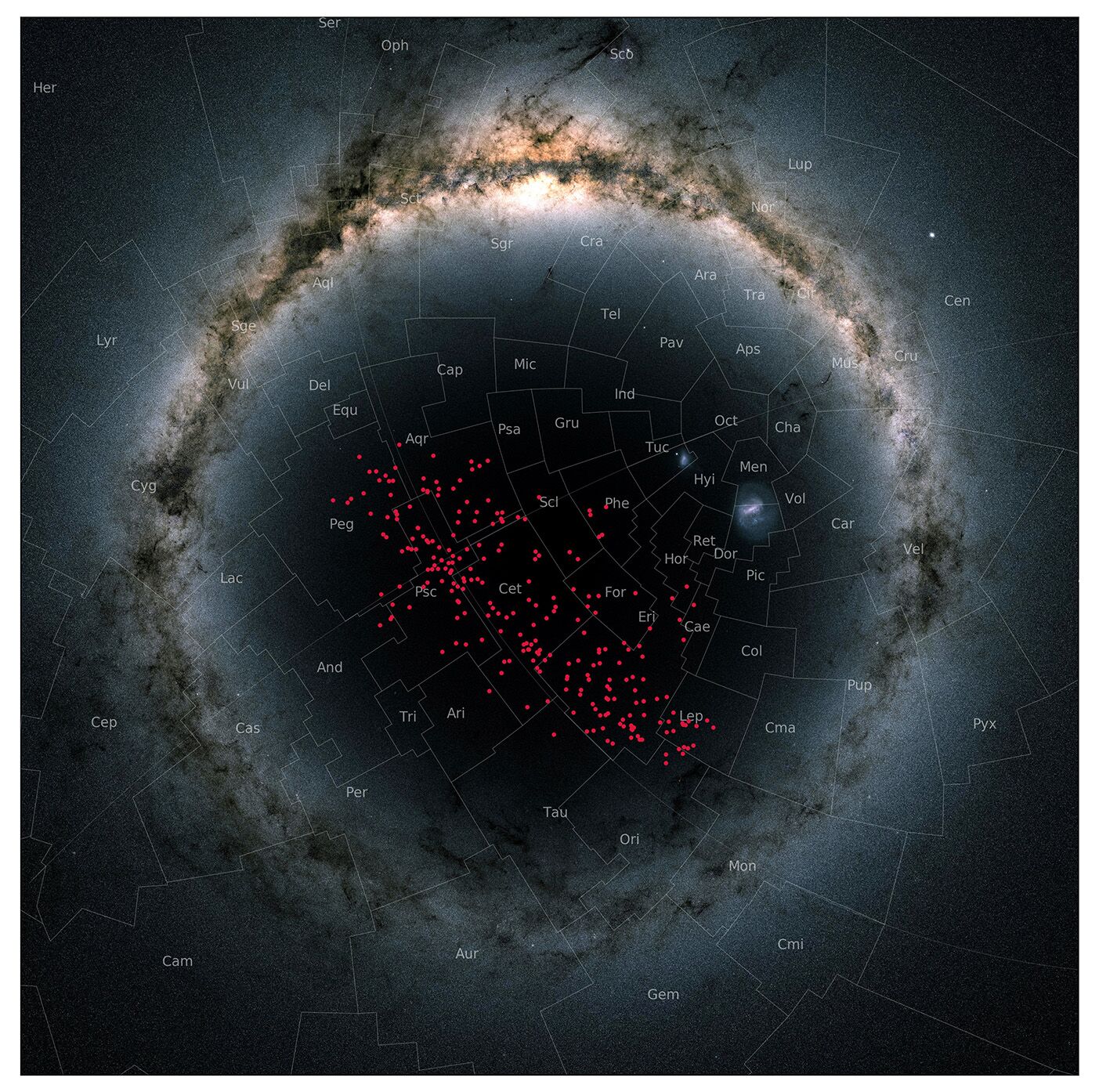IoW_20190218 - Gaia
Image of the Week |
A river of stars |
 |
|
The image above shows the night sky centered on the South Galactic Pole in a so-called stereographic projection. In this special projection, the Milky Way curves around the entire image in an arc. The stars in the stream are displayed in red and cover almost the entire southern Galactic hemisphere, thereby crossing many well-known constellations. Used as background image: Gaia DR2 skymap. Image credits: Stefan Meingast, ESA/Gaia/DPAC |
|
Researchers from the University of Vienna have found a river of stars covering most of the southern sky. Their research titled "Extended stellar systems in the solar neighborhood II - Discovery of a nearby 120º stellar stream in Gaia DR2" was published recently by A&A. The stellar stream is relatively nearby and is thought to contain at least 4000 stars moving together in space since they formed, about 1 billion years ago. Due to its proximity to Earth, this stream becomes a perfect workbench to test the disruption of clusters, measure the gravitational field of the Milky Way, and learn about coeval extrasolar planet populations with upcoming planet-finding missions. For their search, the authors used data from the latest Gaia data release. Our own host galaxy, the Milky Way, is home to star clusters of variable sizes and ages. These clusters, regardless of their origin and age, are all subject to tidal forces along their orbits in the Galaxy. Given enough time, the Milky Way's gravitational forces relentlessly pull them apart, dispersing their stars into the collection of stars we know as the Milky Way. “Most star clusters in the Galactic disk disperse rapidly after their birth as they do not contain enough stars to create a deep gravitational potential well, or in other words, they do not have enough glue to keep them together. Even in the immediate solar neighbourhood, there are, however, a few clusters with sufficient stellar mass to remain bound for several hundred million years. So, in principle, similar, large, stream-like remnants of clusters or associations should also be part of the Milky Way disk.“ says Stefan Meingast, lead author of the paper. Thanks to the precision of Gaia Data Release 2, the authors could measure the 3D motion of stars in space. When carefully looking at the distribution of nearby stars moving together, one particular group of stars, so far unknown and unstudied, immediately caught the eye of the researchers. It was a group of stars that showed precisely the expected characteristics of a cluster of stars born together but being pulled apart by the gravitational field of the Milky Way. "Identifying nearby disk streams is like looking for the proverbial needle in a haystack. Astronomers have been looking at, and through, this new stream for a long time, as it covers most of the night sky, but only now realize it is there. And it is huge, and shockingly close to the Sun” says João Alves, second author of the paper. "Finding things close to home is very useful, it means they are neither too faint nor too blurred for further detailed exploration, an astronomer's dream." The stellar stream extends for a length of about 400 pc with a vertical size - perpendicular to the disk of the Milky Way - of only about 50 pc, but is potentially much larger. Its structure is elongated with respect to its direction of movement and while still moving away from the Galactic plane, its velocity is not high enough to escape into the Milky Way halo. Positions of the final stellar stream member selection in Galactocentric cylindrical coordinates. The Sun's position is indicated with the black circular symbol. The arrows visualise the velocity of the sources in the stellar stream. The sources show a strikingly flat spatial arrangement, extending at least 400 pc along the stellar stream's major axis. Image credit: Stefan Meingast, João Alves, Verena Fürnkranz - A&A 622, L13 (2019)
Due to sensitivity limitations of the Gaia observations, the selection for the stream only contained about 200 sources. An extrapolation beyond these limits suggests the stream should have at least 4000 stars, thereby making the structure more massive than most known clusters in the immediate solar neighbourhood. The authors also determined the stream’s age to be around 1 billion years. As such, it already has completed four full orbits around the Galaxy, enough time to develop the stream-like structure as a consequence of gravitational interaction with the Milky Way disk. “As soon as we investigated this particular group of stars in more detail, we knew that we had found what we were looking for: a coeval, stream-like structure, stretching for hundreds of parsecs across a third of the entire sky.” says Verena Fürnkranz, co-author and Master student at the University of Vienna. "It was so thrilling to be part of a new discovery" she adds. This newly discovered nearby system can be used as a valuable gravity probe to measure the mass of the Galaxy. With follow-up work, this stream can tell us how galaxies get their stars, test the gravitational field of the Milky Way, and, because of its proximity, become a wonderful target for planet-finding missions. The authors hope to unravel even more such structures in the future with the help of the rich Gaia database.
Find here the press release by A&A
|
|
Credits: Stefan Meingast, João Alves, Verena Fürnkranz [Published: 18/02/2019] |
- Removed a total of (7) style text-align:center;
- Removed a total of (4) style text-align:justify;
- Removed a total of (1) border attribute.
- Removed a total of (1) cellpadding attribute.
- Removed a total of (1) cellspacing attribute.
Image of the Week Archive
- Removed a total of (1) border attribute.
- Removed a total of (1) cellpadding attribute.
- Removed a total of (1) cellspacing attribute.








































 Sign in
Sign in
 Science & Technology
Science & Technology
